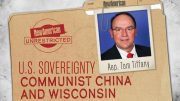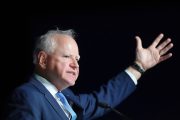Over the Memorial Day weekend, Bill Kristol the editor of the Weekly Standard (which has been described as a “redoubt of neoconservatism” and “the neocon bible”) sent out a tweet stating: “There will be an independent candidate — an impressive one, with a strong team and a real chance.”
The independent candidate that Kristol predicted/proposed was obviously meant to run on a third party ticket as an alternative to the presumptive Republican nominee, Donald Trump, whom Kristol apparently believes has no “real chance” to win the general election.
In response to Kristol’s tweet, Trump tweeted three of his own:
• “Bill Kristol has been wrong for 2yrs-an embarrassed loser, but if the GOP can’t control their own, then they are not a party. Be tough, R’s!”
• “The Republican Party has to be smart & strong if it wants to win in November. Can’t allow lightweights to set up a spoiler Indie candidate!”
• “If dummy Bill Kristol actually does get a spoiler to run as an Independent, say good bye to the Supreme Court!”
Trump’s last tweet was an obvious reference to a scenario in which an independent candidate such as Kristol favors would divide the Republican vote, resulting in the election of Hillary Clinton, who would nominate very liberal justices to the Supreme Court.
Just last week, Kristol said on Bloomberg Politics’ Masters in Politics podcast that he regarded the Republican Party’s 2012 nominee, former Massachusetts Governor Mitt Romney as the GOP’s best bet to win the election in November:
The real last chance here is with Mitt Romney, who has said “no” [to running as an independent] but who I think is thinking seriously about it. He is a very serious person, he really knows that Trump should not be president of the United States. He strongly believes that Hillary Clinton should not be president of the United States.
Kristol continued:
I think a lot of Americans by October after watching Clinton and Trump go at each other could decide that a respectable, serious grown-up person like Mitt Romney could be awfully desirable. The conditions are there. The ballot access stuff is a little challenging but actually manageable, people have overcome those obstacles, so it really comes down to a candidate.
In response to Kristol’s proposal, former GOP presidential candidate Ben Carson, while speaking on Fox News on May 30, advised against going down the independent candidate path. “A quarter of a century ago, another Clinton was running for the White House, and it was the entrance of a third-party candidate, Ross Perot, that made it possible for him to win,” Carson said. “Wouldn’t it be ironic if the same thing happened this time?”
While Kristol’s proposal is motivated mostly by his objections to Trump, there have been third party challengers to the main party nominees every four years since 1972. The Libertarian Party over the weekend nominated former New Mexico Governor Gary Johnson as their presidential nominee and former Massachusetts Governor William Weld as their vice-presidential nominee. Both men served as Republican governors. But independent parties have so far had the power only to play spoiler. As the Libertarian Party’s 2012 candidate, Johnson received one and one quarter million votes, about one percent of the total.
A Fox News report on Kristol’s tweeted proposal revealed a widespread lack of understanding about Kristol’s political philosophy, stating, in part:
Kristol, along with other conservative pundits, long has been working to attract an independent candidate to run in November amid lingering concerns in some wings of the Republican Party about Trump’s conservative credentials.
Though some may legitimately be concerned about Trump’s conservative credentials, the reference to Kristol as a “conservative pundit” ignores his long-recognized position as the heir to a neoconservative dynasty that is anything but conservative. By founding The Weekly Standard in 1995, Kristol followed in the footsteps of his father, the late Irving Kristol, who served as the managing editor of Commentary magazine, founded the magazine The Public Interest, and has been described as the “godfather of neoconservatism.”
The elder Kristol, while attending the City College of New York in the late 1930s, was part of a small but vocal Trotskyite anti-Stalinist group who eventually became the New York Intellectuals. This group of New York-based writers and literary critics were thoroughly Marxist in their thinking, though they rejected Soviet Communism under Stalin’s rule.
Irving Kristol was a member of the internationalist Council on Foreign Relations (CFR) and a fellow emeritus at the American Enterprise Institute (AEI).
In an article published in the June 6 issue of The New American’s print edition, “Implosion of the Never, Never, Never Trump Neocons,” Senior Editor William F. Jasper provided a description of neoconservatism that is essential to understanding the dynamics of the debate between Trump and neocons such as Kristol, noting under the subheading, “The Neocon Con Job”:
Since we have been using the “neoconservative” label here, it may behoove us to define and explain the term, before going further. Although the terms neoconservative/neoconservatism/neocon have gradually entered the public discourse, there remains, in general, a rather foggy notion of their meaning. That is by design. The New American has covered this topic more expansively in previous articles, but in short, here it is: The founding fathers of neoconservatism were mostly hardcore leftists; many were Trotskyite communists who turned against Stalin but retained much of their socialist political ideology and left-wing social/cultural/moral affinities.
With massive help from the Big Media/Big Foundations/Big Government axis, the relatively small clutch of mostly New York City-based neocon “intellectuals” were transformed, in the decades following World War II, into the spokesmen and strategists of the “conservative movement” and the Republican Party. They sounded like traditional conservatives and anti-communists, but they had a subversive agenda to usurp the mantle of conservatism and use it to pervert the constitutional structure and principles that are the foundation of our ordered liberty.
In that article, Jasper also quoted from Irving Kristol’s 1995 book, Neoconservatism: The Autobiography of an Idea, in which the elder Kristol revealed that neoconservatism was more of a neoliberalism, since it represented:
the erosion of liberal faith among a relatively small but talented and articulate group … (which gradually gained more recruits) toward a more conservative point of view: conservative, but different in certain respects from the conservatism of the Republican party. We [neoconservatives] accepted the New Deal in principle, and had little affection for the kind of isolationism that then permeated American conservatism.
A prime example of “the kind of isolationism [more accurately, noninterventionism] that then permeated American conservatism” was the late senator Robert A. Taft (R-Ohio) who was considered to be a favorite to obtain the Republican presidential nomination in 1952. However, the young neoconservative movement had already made inroads into the Republican party and, in an effort to stop Taft, drafted the lifelong Democrat Dwight D. Eisenhower to oppose Taft for the nomination. The neocons coined the slogan “I like Taft but he can’t win” to erode Taft’s support and also used dubious tactics on the floor of the Republican convention to shift Taft’s delegates to Eisenhower. The nomination of Eisenhower began the neoconservative takeover of the Republican Party, and a series of Republican presidents since then have promulgated interventionist foreign policies and big government domestic policies that have been indistinguishable from those presented by the Democrats.
When the Republican Party broke step with the neocons and nominated Senator Barry Goldwater (R-Ariz.) for the presidency in 1964, the neocons and partisans of the party’s Eastern liberal “Rockefeller wing” refused to support the nominee and assured his defeat in a landslide.
And yet, even the revolt of the Rockefeller Republicans against Goldwater in 1964 pales in comparison to the Republican/neocon pundits and writers who have taken the #Never Trump pledge. As Jasper concludes his article:
Whatever faults, foibles, weaknesses, and warts Trump may have — and he has many — we would do well to ignore his critics who have been defending and promoting for decades the gradual destruction of our Republic under the cloak of neoconservatism.
Related articles:
Bill Kristol and His “Code Brown Shirt” Conservatism
The Truth About Neoconservatism
An Honest Assessment of Neoconservatism
Most “Conservatives” Are Secretly Neoconservatives
Blame America? No, Blame Neocons!
Neoconservatives vs. Conservatives: Who Are the Real “Extremists”?
The Neoconservative Philosophy




